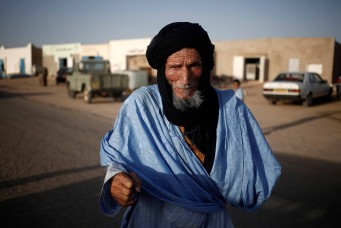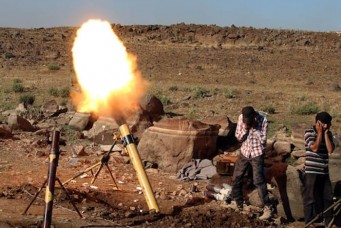Breaking the Deadlock in Western Sahara
Respect for human rights is a common denominator in the Western Sahara conflict that the international community should back at all costs.

Demonstrations have followed one another in Laayoune, Smara, Boujdour and Dakhla since late April, leading in some cases to violent clashes between Sahrawi pro-independence activists and the Moroccan security forces. The largest rally demanding self-determination was reported on May 4 in Laayoune, the capital of the Rabat-controlled Western Sahara territory. Though the Moroccan government restricts access to the area in times of tension like these, the arrival of foreign observers or journalists (such as that of six American and British journalists of the International Women’s Media Foundation starting on April 28) has allowed for a sense of protection and has encouraged and empowered protesters. Meanwhile, the Moroccan government response to these protests has revealed contradiction and miscommunication: the Moroccan minister of Communication claimed that calm and normality prevail in the “provinces of the South,” while his Foreign Affairs and Interior colleagues blamed “external parties,” namely Algeria and the Polisario Front, for plotting to destabilize this area.
This escalation of protests began just as Moroccan political officials and diplomats breathed a sigh of relief regarding the international management of the Western Sahara issue. In mid- April, they had spent two weeks on the verge of a nervous breakdown after the U.S. circulated a draft resolution by which the UN Security Council would extend the mandate of the UN Mission for the Referendum in Western Sahara (MINURSO) to include the monitoring of human rights in both the disputed territory under Moroccan control and the refugee camps ruled by the Polisario in Tindouf, Algeria—the two main scenes of the long-stalled Western Sahara conflict. During this period national newspaper headlines declared: “the U.S. abandons its ally,” and “America slaps Morocco in the face,” reflecting the government’s frantic efforts to kill the motion.
Besides the media outcry, the state of total mobilization included an unscheduled crisis meeting of major party leaders with advisors to the Royal Cabinet that openly bypassed the post-Arab Spring elected government and parliament. The participants categorically rejected what they described in a statement as “partial” and “unilateral” initiatives aimed at “distorting” the MINURSO mandate. In response, Morocco canceled, without explanation, the “African Lion” annual joint military exercises with the U.S. army, and sent a high-level diplomatic mission to “transmit a message” from King Mohammed VI to the governments of several permanent members of the Security Council.
The proposal to update or standardize the mandate for MINURSO to bring it in line with other peace keeping missions that assume responsibilities in human rights vigilance was applauded by international human rights NGOs. However, Rabat saw it as an imminent black-and-white victory for the Polisario Front and pro-independence Sahrawi activists, after a decade-long strategic shift that has turned human rights into a central bone of contention.
Short-term developments provide a rationale for the U.S. initiative, including the departure of Hillary Clinton who had been a supporter of the Moroccan government in the first Obama administration. This is compounded by the increased lobbying and influence of the Robert F. Kennedy Center for Justice and Human Rights, a group committed to the Sahrawi cause, in Democratic Party circles. Furthermore, Morocco’s withdrawal of confidence from the UN Secretary General’s Personal Envoy for the Western Sahara, Christopher Ross, in the summer of 2012 (eventually re-accepted after U.S. and UN pressure) didn’t bode well for Morocco’s standing in Washington. This past April, Ban Ki-moon’s last annual report on this conflict also recommended “further international engagement” in the monitoring of human rights in both Western Sahara and the camps.
Ultimately, however, the proposal to broaden MINURSO’s role represents the culmination of a medium-term strategic reshaping of the Sahrawi pro-independence movement, a new dialectic between groups on the ground and in exile, not unlike that witnessed in the Palestinian case as a result of the first Intifada. The first conspicuous phenomenon was the emergence inside the Moroccan-controlled territory, less than a decade ago, of an increasingly politicised associative elite that opted for a non-violent discourse based on the principles of international law and human rights; this granted it growing visibility, legitimacy and support in the international sphere. Since 2009, the Polisario Front has tried to regain the initiative by fostering contact and connections with associations such as the Collective of Sahrawi Defenders for Human Rights (CODESA), which formerly operated on a seemingly autonomous basis. The renewed alliance was staged during the unprecedented visits of prominent CODESA activists to the Tindouf refugee camps (the first of which took place in September 2009).
Such innovative approaches caused undisguised anxiety among the Rabat authorities, who had been enjoying great receptivity within the international community after the launch of their Autonomy Plan (under Moroccan sovereignty) for Western Sahara in 2007. This led, in parallel, to increased political repression in the contested territory (as shown by Sahrawi activist Aminatou Haidar’s refused re-entry to Laayoune and hunger strike in November 2009 and the violent dismantlement of Gdim Izik’s protest camp a year later) and to a defensive withdrawal within the diplomatic sphere.
In short, the emergence of on-the-ground actors and human rights issues introduced new parameters to the stalled conflict. The UN-led resolution efforts, legally attached to the Morocco vs. Polisario Front dual scheme, have been rather slow to take the new realities into account. The recent unforeseen initiative of the new Obama administration and its UN Ambassador Susan Rice, who did not consult with other members of the Group of Friends of Western Sahara at the UN or Personal Envoy Ross, was therefore a potential turning point. Yet it was doomed, facing insurmountable resistances. Much to the relief of the Moroccan authorities, the terms of the U.S. draft resolution were watered down, against the clock, during the successive discussions within the framework of the Group of Friends and the Security Council itself before the final vote, on April 25, and eventually the U.S. stepped back from its original proposal.
The failed expansion of the MINURSO mandate aborted a change of approach that is necessary—on moral and pragmatic grounds alike— for any resolution of the conflict. Regardless of different views on the future of the Western Sahara, respect for human rights is a non-negotiable common denominator that the international community should back at all costs and, ideally, it is also a way to overcome zero-sum approaches and change the dynamics that have rendered this issue so intractable.
Irene Fernández Molina is a research fellow of the European Neighbourhood Policy Chair at the College of Europe (Natolin Campus).
This article is reprinted with permission from Sada. It can be accessed online at: http://carnegieendowment.org/sada/2013/06/10/breaking-deadlock-in-western-sahara/g9lh




